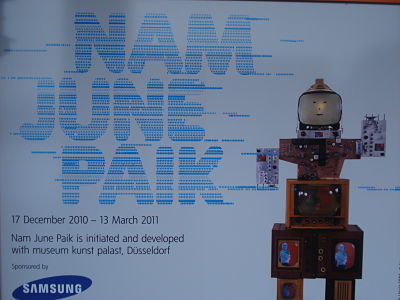
The latest exhibition at Tate Liverpool is the 1st UK retrospective of the hugely influential media artist Nam June Paik. I like a retrospective. It usually provides an opportunity to gain an understanding to an artist, their politics, influences and a career wide look at their art that helps to place them within the context of the age. Liverpool Tate has recently had 2 wonderful retrospectives, on Klimt and Picasso.
The 1st part of the exhibition, displaying pieces from Paik’s early years, is to my mind, the least successful. A room full of seemingly dull, static items; it is only on reading the explanations do you discover that these artworks are being displayed out of context. His 1st solo exhibition was in 1963, and viewers were encouraged to interact with many of the pieces, playing with them. Paik was a great believer in chance and variation, the viewer’s interaction being vital to helping the pieces become the art work they were created to be. It must have been extraordinary in 1963 to be invited into an art gallery and able to play with record players and TVs. There are 2 battered pianos; originally the viewer played them and all sorts of unexpected things happened. Now, there is a barrier round them, and they sit silent. I’m not sure what Paik himself would have made of this. I understand the hugely revolutionary idea that this was the 1st time that TV was used to create, rather than merely present art, but a bunch of TVs that are not turned on does not make for a dynamic exhibition today. It is mundane, stale, and the opportunity for interaction to create ‘chance’ that Paik valued is lost. Is the completed piece the art, or is it the interaction that is art? Therefore, I’m not sure if this is art anymore.
The exhibition becomes more ‘alive’ as you go through, not least because more recent technologies involved are still working. ‘TV Cello’(1971) offers a chance to witness some of the excitement that an audience must have experienced when seeing Paik’s works in performance. The original cello made out of tvs and plexi-glass sits silent. However, a 2nd newer version is set up with the televisions showing the performance with cellist Charlotte Moorman drawing her bow across the cello-tvs which themselves showed footage of her and other cellists playing. Because this is performance art, I appreciate being able to witness some of the performance.
TV Garden (1977), has 60 tvs set amidst plants, showing dance montage. The piece is vibrant and witty, but nowadays, would be the kind of thing I would expect to see as Harvey Nichols window display. Further displays of robots made out of TVs etc are again witty and fun, but never moving.
The second part of the exhibition is held in FACT. I love FACT. Any cinema that shows everything from Harry Potter to John Pilger documentaries, sometimes whilst sat on sofas drinking tea, has got my vote. The centre also contains a number of galleries to exhibit modern art, focusing on media. It just so happens they, rather wonderfully, often get you to lie down to view the art. It isn’t just the obvious things that make it interesting, like a literal change of viewpoint, or even the comfort. You can’t be intellectual or pretentious lying down, you can just enjoy it; it’s the democratisation of art. You’ll be pleased to hear (well, I was), that Gallery 1 encourages you to lie down to view the UK premier of ‘Laser Cone’. And, it’s wonderful. You walk into a darkened room, where lasers spin and whirl onto a cone canvas. You can then lie down under the cone and just be sucked into a world of multi-coloured dancing patterns. I recommend a 15 minute weekday lie down to enjoy this one. Upstairs, there is an astonishing 8 HOURS (*sob*?) of Paiks video montage and installations. There are 4 sofas with a tv in front of each showing a few different films. FACT recommend that you watch a little bit from each of the 4 sofas that encompass Paik’s career, then choose one film to watch all the way through, which actually became an unusual but interesting way to spend an hour. (I was quite excited when I discovered one of the videos featured David Bowie).
I didn’t really learn a great deal in this exhibition, considering it is a retrospective; there are downloadable media guides that I was unable to take advantage of that may have helped. I can appreciate that Paik was a revolutionary artist, who showed great foresight as to how technology would come to shape individuals and our world, and that he wanted to harness and humanise that technology. I think you have to see this exhibition in the context of the time; this was once exciting and dynamic. Now, I just wonder whether that very revolutionary fervour and artistic endeavour has just been surpassed in the days of Big Brother and YouTube.
TATE Liverpool, Albert Docks, £6 entry. FACT Liverpool, 88 Wood St (Off Bold St), free.
Both exhibitions are on now until 13th March